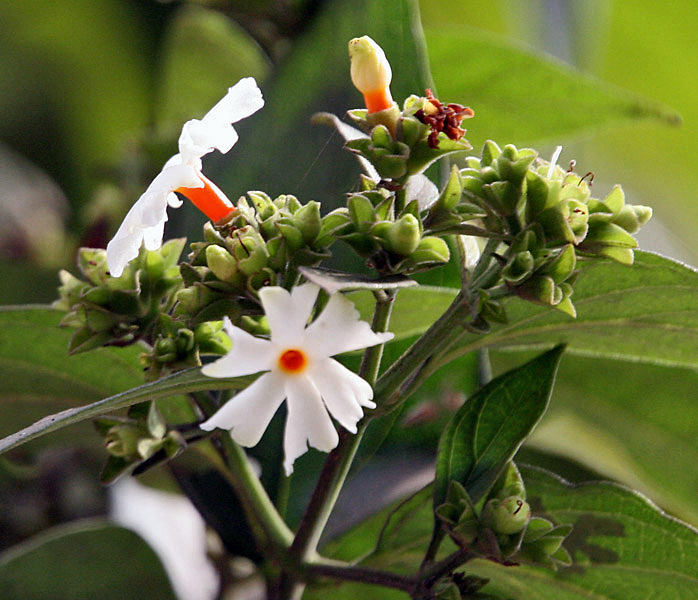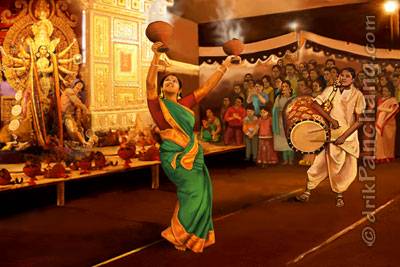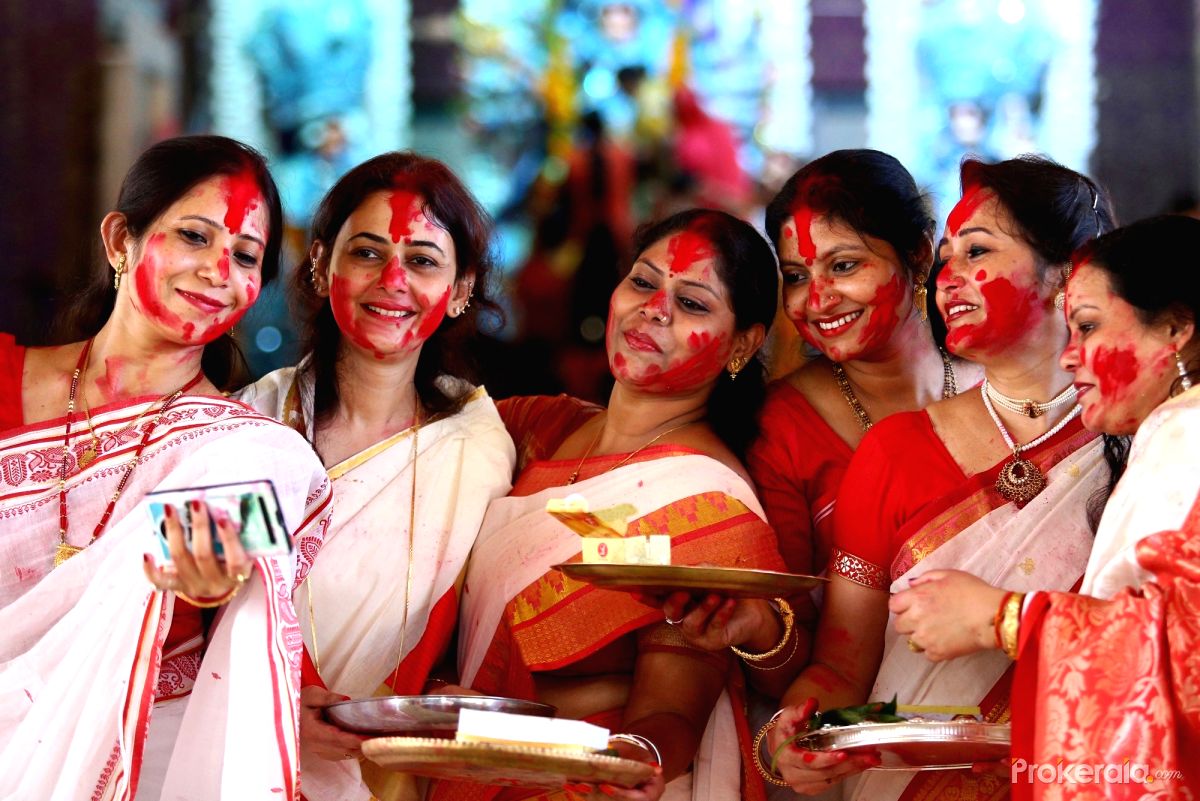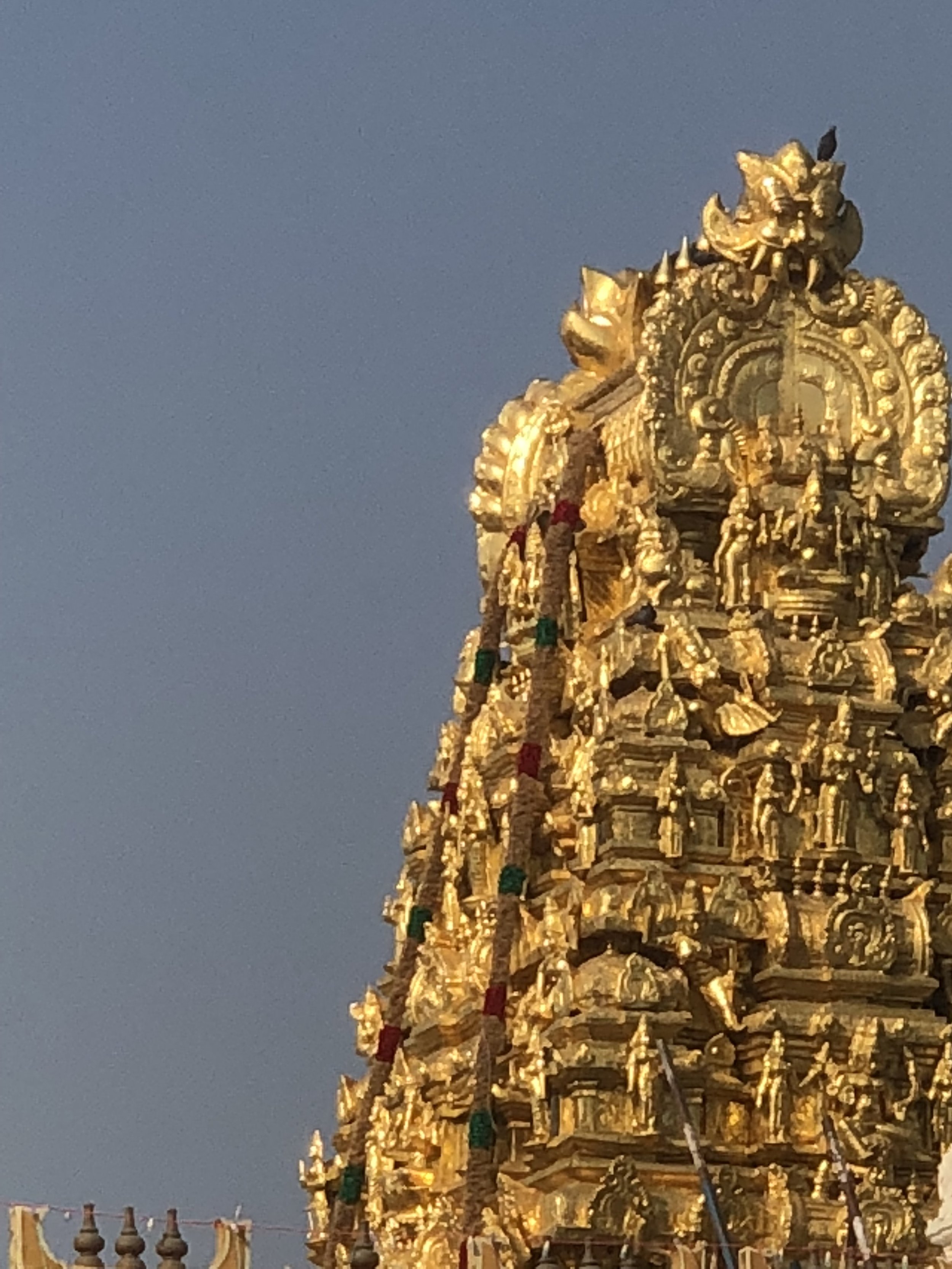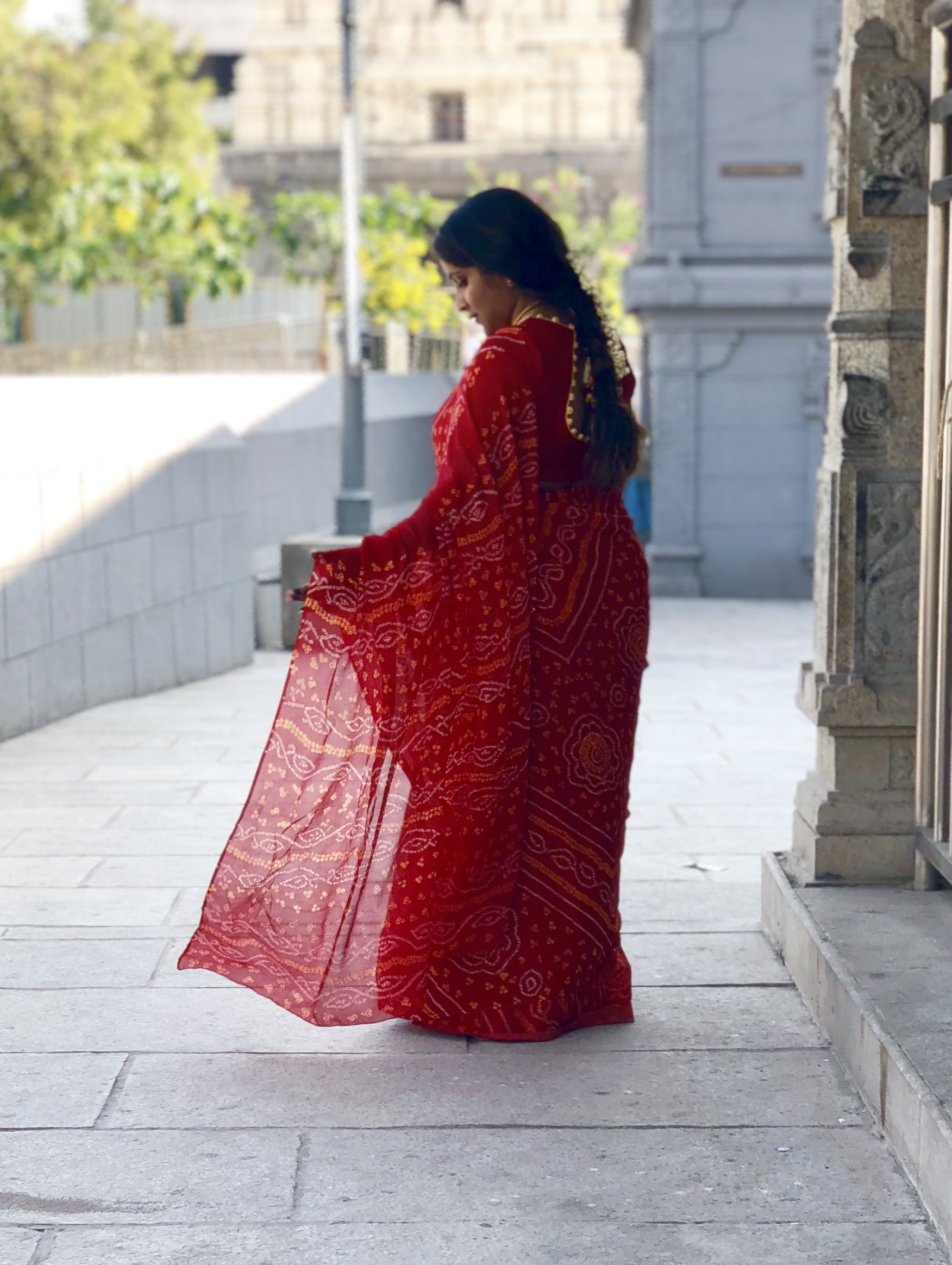Radha is the soul mate of Krishna rather than his lover or wife, which of course their earthly life represented symbolically. Hence, Radha’s role as soul (atma) is more important to understand her central role as feminine divine rather than her life as a simple human on the earth. Even though Radha is born in Barsana and played with Krishna as a child, her life as the special Gopi representing the individual soul (atma) is important to understand her central position in Bhakti tradition. Radha is the symbolic representation of the soul and the personification of the ultimate blissful union through her relationship to Krishna, the purnavatara (complete/total incarnation) of Vishnu.
Shri Krishna painting Shri Radha’s feet at San Diego Museum of Art. Source: Flickr
Ramanuja’s Vishishtadvaita (qualified non-dualism/monism), Vallabha’s Suddhadvaita (pure non-dualism/monism) captures the special relationship of individual soul (atma) with universal soul (brahma), which is symbolically represented through the relationship of Radha and Krishna. Caitanya’s Achintya Bhedabheda (inexplicable identity-difference and indifference), and Nimbarka’s Svabhavaka Bhedabheda (natural identity-difference and indifference) captures this relationship even closely. These two doctrines are also referred to as dvaitadvaita (dual and non-dual), because they explain Krishna as both absolute transcendent as well as dual and distinct together with Radha. Although bhedabheda is utilized as a central philosophy of Krishna devotional schools, it had its origins in the Vedic notion that that difference and unity (non-difference) can co-exist in relation with each other, which finds explicit exposition contained in the Taittiriya Upanisad 3.1.1. As stated in this verse unity is in difference and non-difference, according to which all beings crave unity with brahma, the universal soul, while also consisting of difference, as beings. It explains that although individuals may appear separate and different from the source (the brahma), they still maintain the essence of the source, situated within each individual as the individual’s soul (atma), and hence constantly desire union with the brahma.
Textual and Theological Traditions: Radha, the Gopi to the Atma
Radha appears as an anonymous Gopi, the favorite of Krishna, in texts such as the Bhagavatapuranaand the Cilappadikaram. While the Rasalila section of the Bhagavatapurana spans 5 chapters of the 10th book, it does not mention Radha explicitly, but mentioning the Gopis only as a generic term, while including descriptions of a special Gopi as the favorite of Krishna. She figures as the prominent and favorite Gopi of Krishna during his autumnal rasalila, the round dance in Braj. Numerous forests (groves and arbors) are mentioned in the Harivamsa, the Bhagavatapurana, and the Gargasamhita as favorite places of Krishna to play with his friends the Gopas and also to sport with Radha and the Gopis. Twelve forests are mentioned as settings for Radha and Krishna’s love play, and also the rasa dance, as well as other events in the life of Krishna. Sringaravata is identified as the particular tree associated with the secret randezvous that Krishna went with his favorite Gopi, later identified as Radha. The Bhagavatapurana does not even mention Radha by name, calling her a ‘special Gopi’ of Krishna, while Radha is the central character of the Gitagovinda, noted as an epitome of love. The subject of the Gitagovinda poetry is the Rasalila of Radha and Krishna. However, the separation (viraha) and union, two modes of love found expression in fantasy-laden world. The world of Vraja is transformed in the poems of the Gitagovinda into a heavenly blissful place, where only happiness is found, and thoughts of Krishna pervade. In including Radha as the full-fledged partner of Krishna, the Gitagovinda diverges from the original, although it deals in a similar way with the concept of Rasalila as described in the Bhagavatapurana, which also includes the ‘separation-union’ anxiety of lovers represented by Krishna and the Gopis.
Giri Govardhan by Mihir Chand. San Diego Museum of Art. Source: Flickr
Radha also appears alongside Krishna in early sculptures depicting the events of Krishna’s life, such as Danlila (300 C.E. From Suratgarh, Rajasthan), several depictions of Govardhandharana (lifting Mount Govardhana) from across India, dated from 400 C.E. onwards. Although Radha’s symbolic nature as the soul mate of the ultimate soul is known and enunciated in the classical texts of India, her efflorescence comes after 600 C.E. as she acquires centrality among the spiritual conscious of popular devotional traditions of India. Radha acquired utmost significance as the feminine counterpart of Krishna in the devotional texts, as evidenced by the composition of Andal’s Tiruppavai and Jayadeva’s Gitagovinda. Radha’s representation as the soul mate of Krishna is visualized in several miniature paintings dating from 1200 C.E. onwards depicting her as the partner of Krishna.
Radha is idolized by Andal, the female saint-poet (alvar) of the Southern India, as the ideal Gopi in the Tiruppavai, in which she also invoked the Gopis of Vraja who performed a vow to Goddess Katyayani, so they might obtain Krishna as their husband. In the Tiruppavai, Andal imagines herself as that special Gopi of Krishna, who remains anonymous, praying to Krishna, so she may obtain him as her husband. In a further development of the legend, Andal is even identified as the reincarnation of the favorite Gopi of Krishna in Vijayanagara emperor Srikrishnadevaraya’s compositiong based on the life of Andal, the Amuktamalyada.
Radha’s position as that of equaling Krishna is typical of Vaishnava bhakti traditions from 1000 C.E onwards. Jayadeva’s Gitagovinda epitomizes the sringara of Radha and Krishna and brings it forward as one of the major concepts associated with Krishna.
Bhakti Tradition: The Yugal (atma and paramatma)
Krishna’s constant engagement with the Gopas and Gopis is an illustration of the sakhyabhava (mood of friendship), which is one of the important modes for connecting with the god, in bhakti tradition of worship. In the Bhagavatapurana, even though there were numerous Gopi maidens that desired the company of Krishna, only one Gopi Radha acquired the special position of being Krishna’s favorite cowherd maiden. The Gopis, as described in the Rasalila, connect with Krishna and surrender to him completely. Self-surrender of the Gopis is indicated by two incidents narrated in the Bhagavatapurana, that of Krishna stealing the Gopis’clothes, and that of engaging in the Rasalila dance with the Gopis during the autumnal nights in Brindavan. Rasalila tradition acquires special place in the practice of devotional traditions.
However, Radha’s centrality in devotional traditions can be attributed to the Haritray (the three Haris: Hit Harivams, Hariram Vyas, and Svami Haridas), also known as the rasikatrai (the three connoisseurs of Radha-Krishna). All three of them openly proclaim their loyalty to Radha, referred to as Svamini in their poems. While Hariram Vyas signed off his poems with the signature stamp (chap) of Vyas’ Lady (Vyas ki Svamini), Hit Harivams, and Svami Haridas founded the Radhavallabha and Haridasi traditions, which accord a special place to Radha in their devotional practices. Other Vaishnava sampradayas such as Vallabha, Caitanya, and Haridasi traditions also affirm her superior position as the soul mate of Krishna.
Hariram Vyas’s Ras Pancadhyayi is a poetical composition based on the five chapters of Rasalila from the Bhagavatapurana. Hit Harivams’s texts also include the Sriradhasudhanidhi and the Sphutavani. The Sriradhasudhanidhi contains 270 verses describing Radha’s supremacy within Hinduism, lauding her as “the secret of the Upanishads”. Theologically, Radhavallabha tradition places Radha at the center with its yugal (dual) tradition of worshipping Radha and Krishna as dual aspects of one deity rather than worshipping Radha and Krishna, as two separate divinities. The concept of do deh ek pran (two bodies one soul) is illustrative of the Radhavallabha tradition. Radha is the primary center of worship as a way to reach Krishna through bhakti. For Haridas, the central bhava to reach Krishna is Madhuryabhava (love) of Krishna and Radha, so Radha and Krishna are worshipped in a joint form (yugalsvarupa) in recognition of their pastimes in Braj (nityavihara).
Rasikapriya, Created: early 19th century.
San Diego Museum of Art. Flickr
Radha’s rise to such a central position is also accompanied by theological developments within Vaishnava devotional traditions. Caitanya, founder of Gaudiya Vaishnavism (also known as Caitanya Vaishnavism), is considered an incarnation of Radha and Krishna together. Rupa Gosvami noted that Radha represents the highest rasa, the mahabhava. Hence, according to the Caitanya Vaishnavism, she is the hladinisakti of Krishna, revered even by Krishna. This theory is taken a step further in the Vaishnava Sahajiyatradition of Bengal, which applies Radha-Krishna concept to tantric practice. According to Vallabha tradition she is the svamini of Krishna, who is worthy of devotion. As noted above, the Haridasi and Radhavallabha sampradayas consider Radha as supreme, even above Krishna. The Gitagovinda represent the divine love of Radha and Krishna, although Radha’s actual relationship to Krishna is ambiguous, while Baru Candidasa’s Srikrishnakirtana represents Radha as another person’s wife, thus making her ‘parakiya’ and her love for Krishna as one beyond human bonds.
The later puranas reflect these theological developments within the devotional traditions, and describe her as the special partner of Krishna. According to the Brahmavaivartaprana (1500 C.E.) Radha is depicted as eternally sporting with Krishna in Goloka, the divine world of Krishna. The Devibhagavatapurana and the Padmapurana describe her cosmological role as prakriti and sakti. Radha’s birth place, Barsana, is a major pilgrimage center, and the festival of Holi is celebrated by the devotees while imagining Radha among their midst there in Barsana every year.
Although the male and female divinities are frequently noted as purusha (male unchanging force) and prakriti (Female changing and pulsating energy) contributing together to sustain the creation, the relationship of Radha and Krishna is described uniquely in Hindu classical tradition. Even though Krishna understood as purusha and Radha is understood as energy sakti their relationship is beyond creation, represented in the form of the union of the atma and paramatma.
about the author
Dr. Lavanya Vemsani
Lavanya Vemsani, award winning scholar and professor of History specializing in Indian History and Religions, is Professor of History in the department of Social Sciences at Shawnee State University, Portsmouth, Ohio. She holds two doctorates in the subjects of Religious Studies (McMaster University) and History (University of Hyderabad). She was awarded South Asia Council of the Canadian Asian Studies Association's (SACA/CASA) Best Thesis Honorable Mention prize for her Ph.D. thesis at McMaster University.
Her research and teaching interests are varied, and multifold. She researches and publishes on subjects of ancient history and religions as well as current history of India. Her books include Modern Hinduism in Text and Context; Krishna in History, Thought, and Culture: Encyclopedia of the Hindu Lord of Many Names; Hindu and Jain Mythology of Balarama. She is the Editor-in-Chief of American Journal of Indic Studies; Managing Editor of International Journal of Indic Studies and Editorial and Review Board Member of Air Force Journal of Indo-Pacific Affairs as well as Canadian Journal of History. She is current Vice-President and President-Elect of Ohio Academy of History (2018-2020).

















